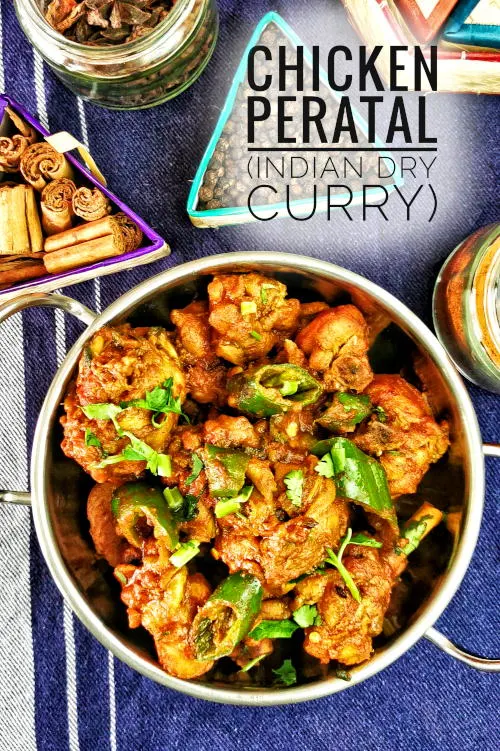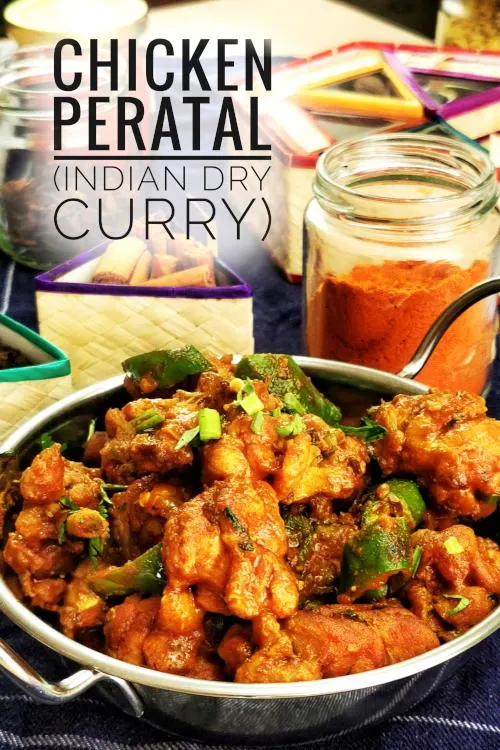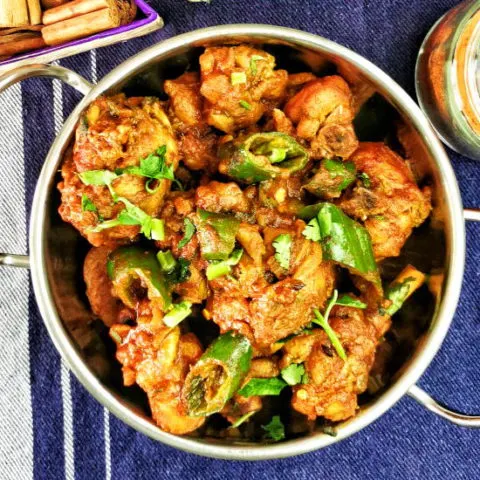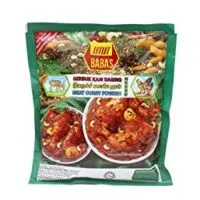Deepavali is just a few days away, and this chicken peratal recipe is just fit for the occasion.
Chicken peratal is a must-have Southern India dry curry dish to be included in your festival feast this time.
This dry curry recipe is my interpretation using Malaysian curry powder. Therefore it might be slightly different from the authentic Tamil-style curry. It is medium hot and has all the flavor cooked down to a thick, nearly dry gravy.
Don’t miss this amazing dry curry if you like Indian food. It has all the classic elements of Southern Indian food: spicy, complex, and the savory flavor lingers on your palate.
Let’s get into the details.
Note: This post may contain affiliate links. Please read my privacy policy for more info. I may receive commissions for purchases made through links in this post. As an Amazon Associate, I earn from qualifying purchases.

1. Ingredients required to cook chicken peratal
You may find there is a long list of ingredients in the recipe. In fact, there is a lot of repetition. Once you get all the ingredients ready, the process is relatively easy. Here is the explanation of the main ingredients used in chicken peratal.
a. The spices
What makes chicken peratal so delightful is the spices. Therefore, it is essential to use fresh spices. Hence, I use whole spices and also some freshly ground spices.
The whole spices are cinnamon stick, star anise, cloves, cardamom, fennel seeds. These spices are carefully sauteed in oil to bring out the aroma before cooking with the chicken.
The ground spices are turmeric powder, chili powder, curry powder, coriander powder, and fennel powder. Since this is the Malaysian Indian style chicken peratal, I use the Malaysian curry powder, widely used in different Malaysian curries. Therefore the flavor of this dish may be slightly different from the original recipe from Southern India.
b. Ginger-garlic paste
Ginger garlic paste is extensively used in Indian cuisine, with no exception to chicken peratal and chicken varuval (another dry curry). You can make a generous amount if you cook Indian food regularly. The preparation is easy. All you need is to blend an equal portion of ginger and garlic into a paste. You can also use a mortar and pestle if you wish. You can finely chop both if you just require a small amount. Lastly, you can purchase it online.
c. Onion and tomato
Onions form the body of the thick gravy. I fry the onion until slightly golden to make it more aromatic before stewing with the chicken. This step accentuates the taste, but some cooks may just skip the frying part.
Some peratal recipes do not include tomato, but I like it as it contributes some flavor and helps form the gravy.
d. Use bone-in chicken, and marinate
It is best to use bone-in chicken because the bone releases flavor to the gravy while cooking. The chicken chunks should preferably be small for greater absorption of the flavor from the spice. I use drumsticks in this recipe, but you can buy the whole chicken and cut it into small chunks.
Marinating the chicken for at least one-hour yields the best result. I use turmeric powder to marinate it, which gives it a yellowish color. I also added all the salt required for the recipe to marinate the chicken. This method helps to let the salt penetrate thoroughly into the thicker part of the meat. In general, 10g of salt for 1kg of chicken (i.e., one percent) is my rule of thumb to season any meat.
e. Curry leaves and Malaysian curry powder
Curry leaves are a regular item used in Malay and Indian cuisine in Malaysia. I use it for cooking most of the curries as it adds an aromatic flavor to them. It turns out more aromatic if you fry them briefly, so I saute it with other whole spices for a short while.
This recipe also includes Malaysian curry powder, so it is a Malaysian Indian-style dry curry. I think many Indian dishes have evolved and are being reinterpreted to suit local tastes.
f. Green chilies, curry powder, and coriander leaves
Another ingredient I like to use is green chilies. Since the chili powder I use is made with red chilies, the flavor is more wholesome if I include some fresh chilies. Moreover, green chilies also double up as garnish while serving.
I also rough chop two stalks of coriander and mix half of them with the chicken right before removing them from the pan. Sprinkle the other half on top of the chicken to garnish.

2. How to prepare the best chicken peratal (Indian dry curry)
I prefer to start the preparation by frying the chicken chunks with some oil. The purpose is to brown it slightly for better flavor, so it is OK if they are not fully cooked. Once the chicken is brown, remove them and use the remaining oil in the pan to fry the onion.
Here are my tips for cooking the best chicken peratal:
- Use fresh herbs. There is no substitution for fresh, whole spices. Make sure the spices are fresh, and the ground spices are way before reaching the expiring date. If you do this, the aroma of spices will still linger on in the mouth after eating!
- Use bone-in chicken. Bone enhances the flavor of the gravy. You can add some chicken stock instead of water to prepare it if you use boneless chicken.
- Use the oil after frying the chicken to fry the onion and the whole spices. The oil is full of chicken flavor. You may want to reserve some oil for other purposes as it can be too much if you use it all.
- Be careful not to burn the dry spices while lightly sauteing them. The dry curry will taste bitter if you burn the spices.
- The amount of chili powder can vary depending on the level of spiciness you desire. While adding the chili powder, please keep in mind that the curry powder is also slightly spicy.
- The chicken tastes even better if you keep it for half a day or overnight after the flavor of the gravy absorbs thoroughly into the meat.
Note: Chicken peratal is a dry curry that closely resembles chicken varuval. However, Varuval is more of a dry dish, and there is little or no gray.
3. To serve
Chicken peratal is a popular festive dish during Deepavali, but certainly also suitable for everyday cooking because it is easy to prepare. It serves as the main dish with rice, ransom, or curd rice.

Chicken peratal - How to make Indian dry curry (celebrate Deepavali)
Deepavali is just a few days away, and this chicken peratal recipe is just fit for the occasion.
Chicken peratal is a must-have Southern India dry curry dish to be included in your festival feast this time.
This dry curry recipe is my interpretation using Malaysian curry powder. Therefore it might be slightly different from the authentic Tamil-style curry. It is medium hot and has all the flavor cooked down to a thick, nearly dry gravy.
Ingredients
Ingredients A (marinate)
- 1kg chicken, medium size pieces
- 1 tsp turmeric powder
- 2 tsp salt
Ingredients B (dry spices)
Ingredients C (to make 3 tbsp ginger garlic paste)
- 1 inch ginger
- 6 cloves garlic
Ingredients D (others)
- 2 onions, sliced
- 2 medium-sized tomatoes, diced
- 1 tsp turmeric powder
- 1 tbsp chili powder
- 2 tbsp curry powder
- 1 tbsp coriander powder
- 1 tbsp fennel powder
- 2 tsp sugar
- 1/4 cup water
- 2 green chilies, cut on the bias into short sections
- 2 stalks coriander leaves, chopped
Instructions
- Marinate the chicken with ingredients A for half a day.
- Fry the chicken with oil until it turns light brown. Removed from oil.
- Fry the onion slices with the remaining oil until golden. Removed.
- Remove from the excess oil. Leave about 1/4 cup in the pan.
- Add ingredients B (dry spices), saute over low heat for two minutes.
- Add ingredients C, followed by diced tomatoes. Saute for five minutes.
- Add the chicken, onion, turmeric powder, chili powder, curry powder, coriander powder, fennel powder, sugar, and water. Mix well.
- Simmer over low heat for twenty minutes or until it forms a thick gravy.
- Add the green chilies and half of the coriander leaves.
- Dish out and garnish with the remaining coriander leaves. Serve.
Recommended Products
As an Amazon Associate and member of other affiliate programs, I earn from qualifying purchases.
-
 BABA Meat Curry Powder 500g - 17.64oz
BABA Meat Curry Powder 500g - 17.64oz -
 Dried Curry Leaves | Aromatic and Distinctive Flavor | With All the Flavor of Fresh Leaves | Kari Patta 1.5 oz.
Dried Curry Leaves | Aromatic and Distinctive Flavor | With All the Flavor of Fresh Leaves | Kari Patta 1.5 oz. -
 Lodge 3.6 Quart Cast Iron Casserole Pan. Red Enamel Cast Iron Casserole Dish with Dual Handles and Lid (Island Spice Red)
Lodge 3.6 Quart Cast Iron Casserole Pan. Red Enamel Cast Iron Casserole Dish with Dual Handles and Lid (Island Spice Red) -
 Avs Stores Set of 4, Pure Copper, Stainless Steel Bowls with Solid Brass Handle Serveware Accessories Karahi Pan for Indian Food,Diameter- 7 Inches
Avs Stores Set of 4, Pure Copper, Stainless Steel Bowls with Solid Brass Handle Serveware Accessories Karahi Pan for Indian Food,Diameter- 7 Inches
Nutrition Information:
Yield: 4 Serving Size: 1Amount Per Serving: Calories: 666Total Fat: 34gSaturated Fat: 9gTrans Fat: 0gUnsaturated Fat: 21gCholesterol: 235mgSodium: 1421mgCarbohydrates: 26gFiber: 7gSugar: 10gProtein: 64g
This data was provided and calculated by Nutritionix on 10/31/2021

Greg Larson
Tuesday 9th of November 2021
Do you have other Dry-Curry recipes?
KP Kwan
Wednesday 10th of November 2021
There is one called chicken varuval which is dryer than this. You can check it out: https://tasteasianfood.com/chicken-varuval/
Meg Tan
Thursday 4th of November 2021
Tried this dish today (Deepavali) and it’s really good Thnks for sharing
KP Kwan
Friday 5th of November 2021
You are welcome and glad that you like it.
Yolly belo
Wednesday 3rd of November 2021
Tnx for new recipe ❤️❤️
KP Kwan
Sunday 31st of October 2021
Hi, this is KP Kwan. I am happy to see you in this comment area, as you have read through my recipe. I am glad to reply to any questions and comments as soon as possible.